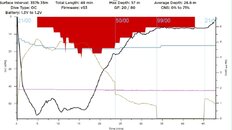Getting bent twice in 1500 dives is just how the dice roll. I'm going to disagree with
@kensuf here, its totally possible to get bent on 30/70. Recreational divers think of that as "super conservative" but its not in the grand scheme of things. Compare with the commercial deco profiles published this month in DAN. They do WAY more deco than us fun divers do.
Alert Diver | Anatomy of a Commercial Mixed-Gas Dive
Going forwards I would:
1) Add helium where you can, there is no "residual helium time" on repetitive dives. Even if there was, the maximal offgassing gradient at the surface is eliminating it super quick.
2) move up the GF 30low to 50ish, don't add any deep stops.
3) extend your O2 time, especially on the second dive. E.g. Do all your o2 time at 6m. Once your shearwater is clear at 6m spend an additional 10mins at 3m. Don't extend 50% stops, move efficiently through the 50% stops and get to the O2, if this is a repetitive dives "problem" its the slow tissues that are your issue.
4) Limit yourself to one 50-60m dive a day, if you are going to do a repetitive dive make it shallow (<40m) and do extra deco. (not ideal but an idea)
5) Keep the 3+hr surface intervals
6) Work out and lose some weight
7) Get a thicker wetsuit or even a tropical drysuit, make sure you are downright toasty on deco
8) Guzzle water before and during dive days
(I can dig up citations evidence but in the interest of brevity left those out)




